To organise biosecurity, a series of standard operating procedures (SOPs) should be written by the whole farm team. Writing these SOPs requires the farm health team to understand the epidemiological behavior of each relevant pathogen, for example:
- Is the pathogen transmitted by contact only or by aerosol spread?
- Is the pathogen spread through insect bites or injections?
While this paper uses the pig to illustrate the principles, biosecurity enhancement will benefit any livestock enterprise. Biosecurity principles are applicable to all sizes of farming operation.
Biosecurity: foreign incursions — external biosecurity
External biosecurity includes:
- Animal entry points
- Location of the farm
- Transportation
- Rodent, bird and insect control
- Other animal incursions
- Feed and water systems
- Plant and equipment
- People and visitors (including the veterinary health team)
- Medicine and vaccines.
Foreign incursion: animal entry points (pigs)
Once written the SOPs must be instigated and enforced. This is a major role for the farm's veterinary surgeons.
The owners of the farm, in the authors' experience, are often the weakest link, with respect to enforcing SOPs. They often believe that the SOPs they have agreed to do not apply to them and they enjoy diplomatic immunity from the inconvenience of following the rules. The veterinarian is there to speak for the pigs and must make their comments heard above the protestations of the owners/bosses.
Major risks
There are a number of major risks — these include:
- Future breeding stock — gilts and semen
- Other pigs—wild pigs, wild boar, feral pigs, escapees from other farms. Other Suidae (where applicable)
- Slaughter stock in transit — where pathogens move by aerosol from vehicles tail gaiting or parked next to each other in truck stops
- Fallen stock/dead pigs — the fallen stock collection vehicle may already have other dead pigs or organic material on their truck.
- Pork products — many pathogens are resistant to smoking and curing, e.g. African swine fever virus (ASFV) and classical swine fever viruses. A lot of pork products are eaten uncooked. Frozen product will defrost and leave drip, which may contaminate equipment and enter the pig buildings. Never place food products in the medicine refrigerator. The medicine refrigerator should be considered a chemical store. Pork products should be banned from the pig unit and never be within reach of the pigs
- Pig faeces — from other farms can be transported on hands (under fingernails in particular), clothing, boots and equipment.
Pigs not invited into the unit = the perimeter fence
Pigs are naturally curious creatures and will explore their surroundings searching for food and mates. A pig farm is an obvious target with food ideally formulated for their needs (Figure 1) and plenty of potential mates (Figure 2). The solution includes:
- Instigation of a 100 m low crop exclusion area — pigs do not want to become exposed to potential predators and are reluctant to cross 100 m of open ground. Do not make it easy for pigs to come close to the farm undetected under the cover of large crops, e.g. wheat or barley sown right up to the farm buildings.
- Installation of a secure pig proof fence — in the authors' experience very few farms have adequate fencing. The fence needs to encircle the whole of the perimeter of the unit, not just look good at the entry point.
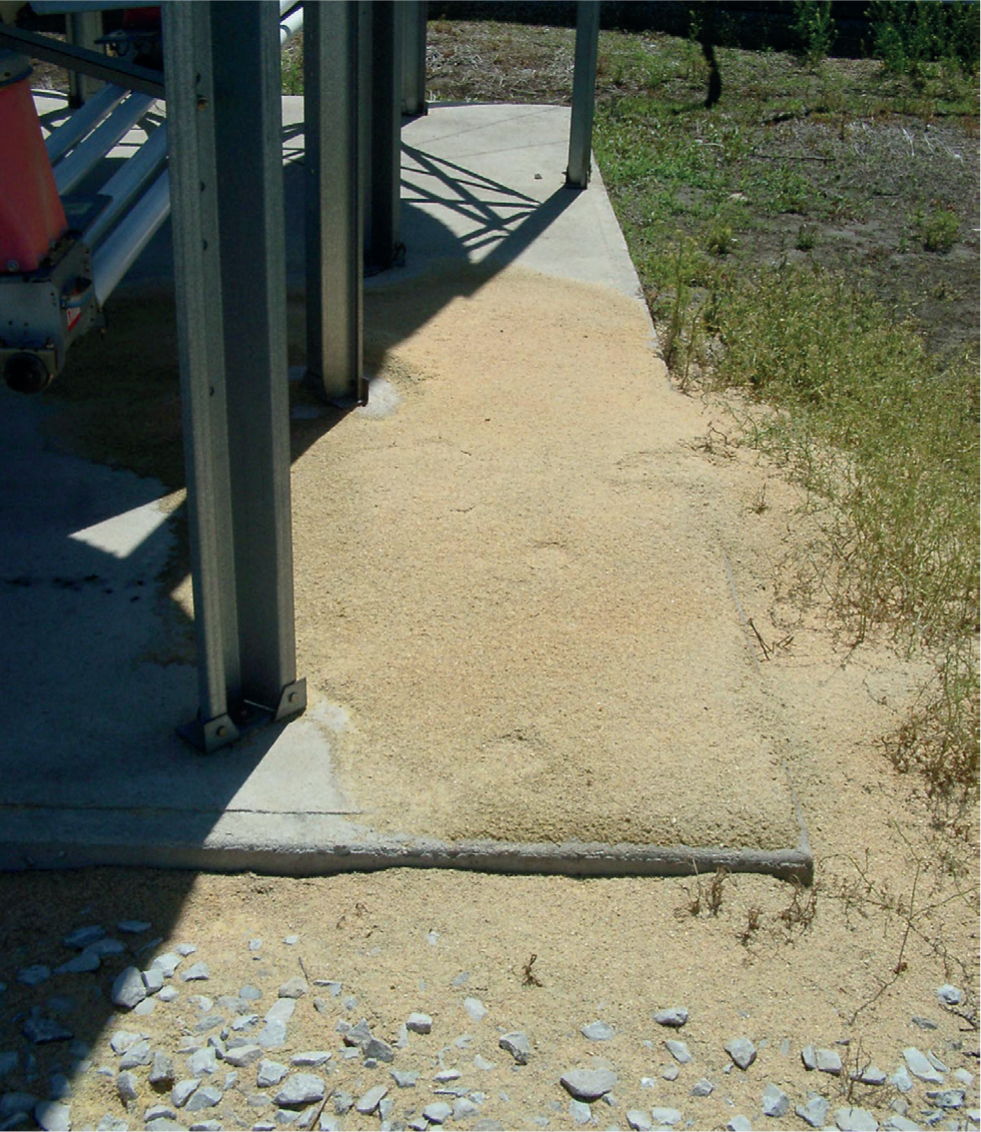
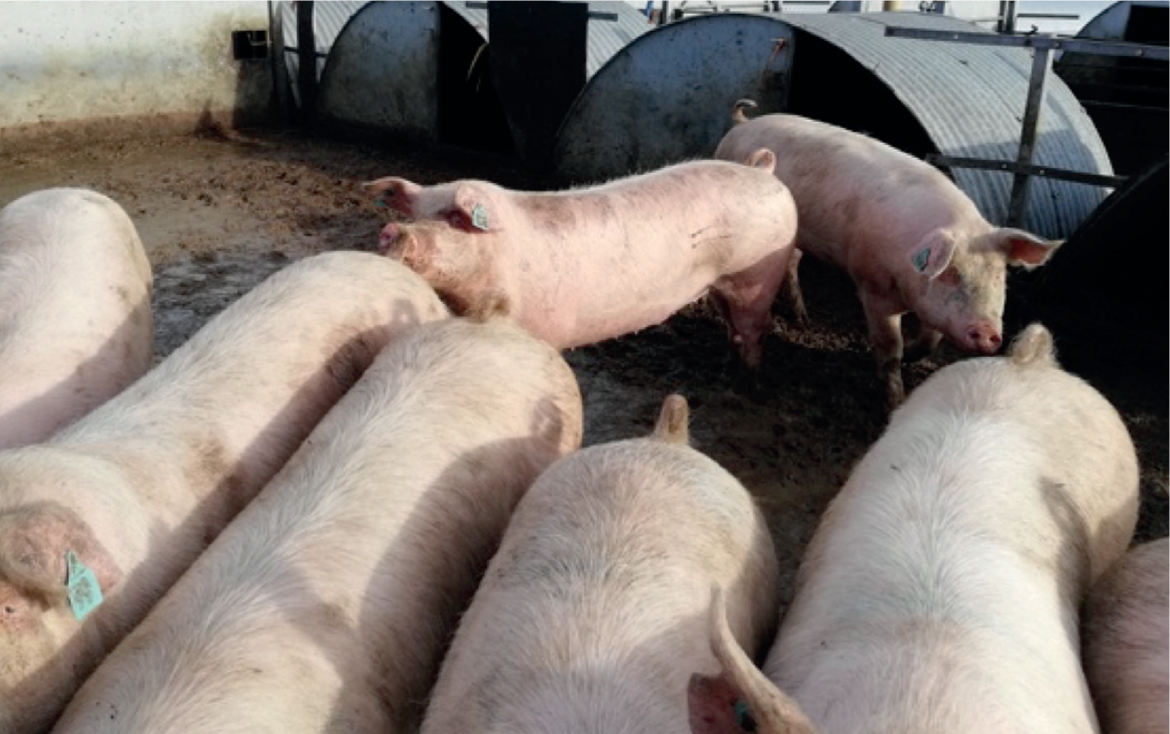
Construct the perimeter fence to stop pigs from digging under it either by fixing it into the ground or burying it 0.5 m deep into the ground. The pig's nose is a prehensile organ capable of imparting tremendous destructive force. Adult pigs may be 300 kg and able to run at 30 km/hour — they are quite capable of destroying a poorly designed fence. The fence must be tall enough to stop pigs jumping or climbing over, i.e.at least 2 m tall. It also needs to be robust enough to stop people entering the farm. The perimeter fence must be well maintained and checked regularly. The farm health team must be able to see both sides of the bottom of the perimeter fence.
Farm location and disease risk
Review the location of the farm using mapping tools. Establish the specific pathogen status of the adjacent farms.
If the farm is within 1 km of another established farm, porcine reproductive and respiratory syndrome virus (PRRSV) may be impossible to eliminate, should the adjacent farm(s) become positive. The veterinarian should always watch for the establishment of finishing units using old cattle housing. Local knowledge of the farming situation can be vital for a farm's survival.
Mycoplasma hyopneumoniae-negative farms should be at least 3 km away from positive units. Whereas, AFSV aerosol transmission over 3 m is unlikely.
Cross-species transmission risk should also be considered, e.g. foot and mouth disease virus (FMDV) from local ruminants. Although the transmission from cattle to pigs is generally less than 500 m, the transmission of FMDV from pigs can be over considerably longer distances.
Transport and pathogen transfer
Vehicles (off-farm) are nearly impossible to adequately clean and must be regarded as ‘high risk’. It is better not to allow any off-farm vehicles through the perimeter fence, and transship material from off-farm to on-farm.
Also consider:
- Cars — owners, staff, visitors and especially veterinarians' vehicles
- Feed trucks
- Animal movement trucks
- Fallen stock collection trucks
- Medicines and artificial insemmination (AI) delivery vehicles.
Rodent, bird and insect control measures
Rodent control
Rodent control is often very poor on farms, although rodents can transmit Salmonella spp. and Leptospira spp. The farm health team needs to understand rodent fear behaviour so that they instinctively reduce risks (Figure 3). A 1 metre wide, well maintained clear-way around all farm buildings (Figure 4) will significantly reduce rodent incursion because rodents are reluctant to expose them-selves to raptor attack. Encourage owls and other external predators to reduce the local rodent population off-farm, being mindful of the risk posed to wild animals by rodent baits.
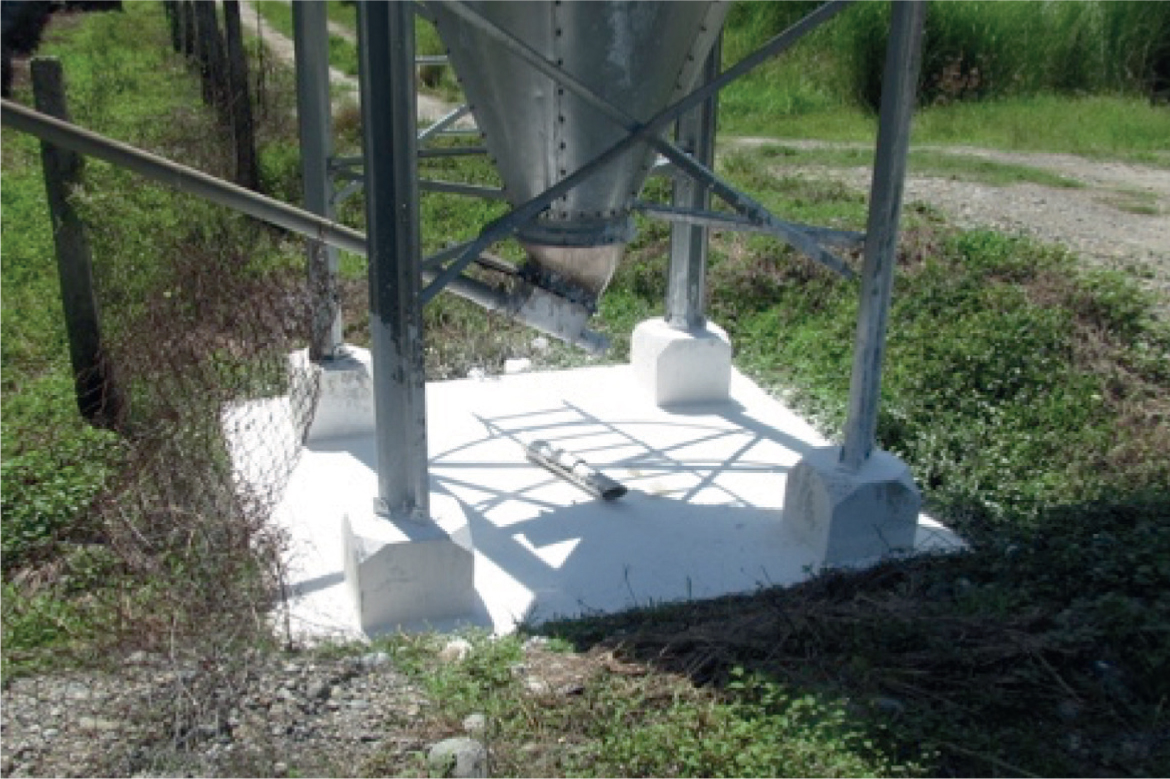
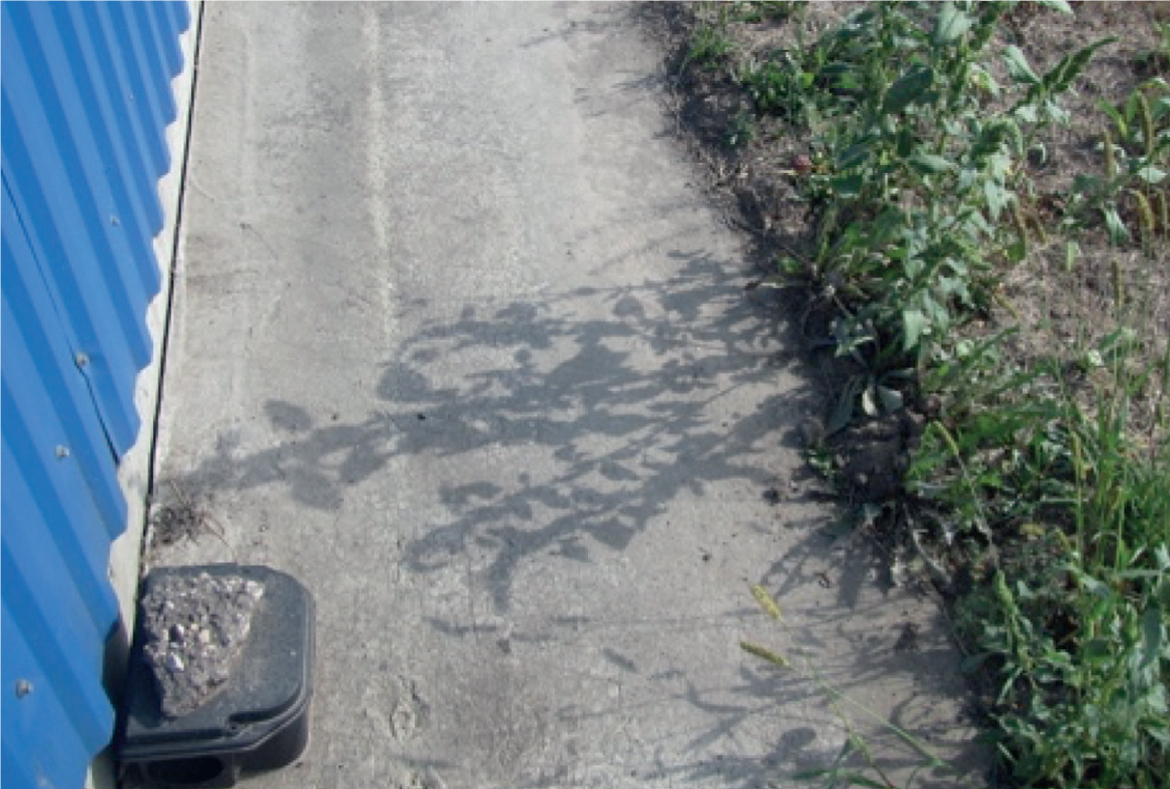
Practice an aggressive on-farm rodent baiting programme. Stop all careless feed spillages and when they happen clear the feed away immediately (Figure 1); pay special attention to external feed bins.
Bird control
Birds should be excluded from the pig farm, but this can be impossible in open yard systems. Birds can transmit coronaviruses and Salmonella spp. on to farms. Covering all feeders and hoppers will help and also reduce faecal feed contamination.
Flies and arthropod control
Biting flies and mosquitoes can transport ASFV and PRRSV between farms. Flies are notoriously difficult to control. Air filtration systems help to keep flies out of buildings, but they are very expensive and flies may compromise this type of ventilation system. Placing a bright light by the exit fan to attract flies, so that they are then blown out of the building can help eliminate flies.
Other arthropods e.g. Sarcoptes scabiei var suis must to be excluded from the farm. Ticks (Ornithodoros spp.) are vectors for the spread and maintenance of ASFV, although evidence that ticks have played a role in the current spread of the out of Africa ASFV II Georgia pandemic is lacking.
Other animal incursions
The farm needs to have suitable precautions to stop other animals spreading pathogens especially dogs and cats. Nearby sheep, cattle and poultry on the farm also pose a risk; the major political concern is influenza but intra-species transmission in rare, but on a day-to-day risk, Salmonella spp. and Mycobacterium avium are real concerns.
Feed and water systems
The farm health team has to trust the quality of the available feed-stuffs. With the globalisation of ingredients, this has become more difficult and a 40-day holding time for natural ingredients seems prudent. Ensure that feed is not infected in the feedmill (Figure 5)
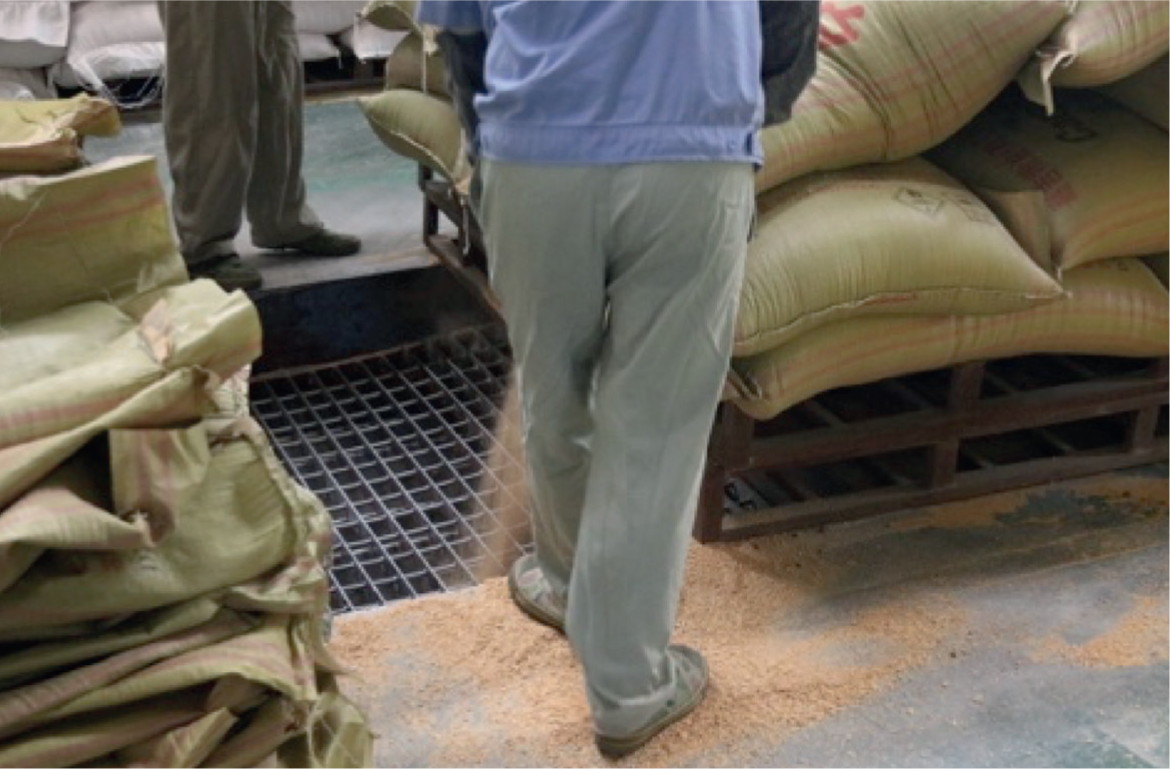
Food quality grains are grown around the world and wild pigs live in (Figure 6) and eat the grain crops. It is possible they might be killed during combining or accidentally assimilated by the combine harvester in ASF infected areas. That said, there is no evidence of the spread of any major pig pathogen with grains on a global basis.
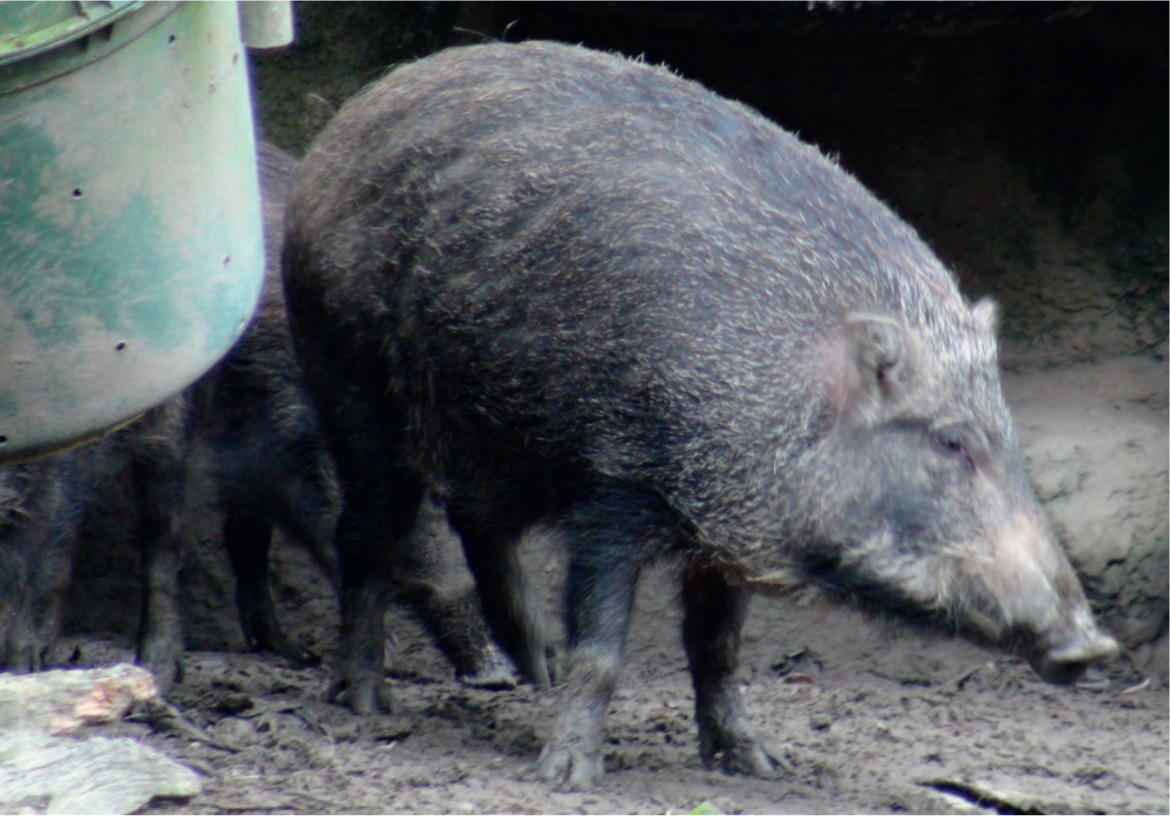
Water is a potential medium for the spread of pathogens, for example dead animals are sometimes thrown into rivers by farmers. This has been seen in Asia and has been the source of spread of ASFV between farms and possibly between countries. Other animals and pathogens may live in the water, e.g. Erysipelothrix rhusiopathiae infected trout, can infect pigs living on a farm taking water downstream.
Equipment
New equipment should pose little risk. but should be washed and disinfected prior to use. Utilise sunlight's natural UV rays to assist in disinfection. Avoid the use of second hand purchased equipment, if possible, but if it has to be used, ensure it is thoroughly cleaned, properly disinfected and rested before it is used.
Building and maintenance
The veterinary surgeon needs to play an active role in designing programmes to ensure that visitor equipment is clean and does not pose a threat to the farm. Several outbreaks of ASFV in Eastern Europe have been traced to maintenance staff, in particular pathogens might be found on the electrical extension cables used to power tools — analogous to feed pipes on trucks. This provides an opportunity for the veterinary surgeon to demonstrate good first principles with their own equipment; have the farm provide essential equipment, including post-mortem examination tools and the more mundane pen and paper. Visit notes can be photographed and exchanged by email, so the paper does not pose a risk to the next farm.
In an attempt to enhance the welfare of pigs, it has become popular to put out wooden blocks as toys for pigs. Wood can be extremely difficult to clean and negates the point of all-in/all-out unless they are replaced with new material each batch.
Personnel
People are often considered to be the major biosecurity risk, but in reality they are seldom an issue. They may carry pathogens on their clothing, hands and boots, but if they are carrying pathogens, e.g. on their tonsils, it is not going to matter how much showering is carried out.
Visitors to the farm should always be provided with boots and outer clothing at the very least. Ideally the farm should also provide veterinary health equipment, which would include post-mortem examination equipment, camera, pen and paper.
Visitors who hunt, especially wild boar, pose a serious risk to pig farms because they handle and butcher their prey. They will become heavily contaminated with any pathogens present in the prey. ASFV, is killing wild boar in many countries and hunters' finding these pigs can act as unwitting vectors to farmed pigs. It is essential that all hunters take this responsibility seriously.
Medicine and vaccines
Many pathogen preventative medicine programmes rely on live vaccines. Deploying live vaccines on farms where the target organism is absent carries the risk that the vaccinal strain may combine with the native pathogens and produce a more virulent form. Live vaccines should be less virulent than the local strain(s). The ASFV vaccines to be trialed (2020) are all live vaccines and have limited application at present. Vaccines are manufactured in cell lines and these cell lines could become contaminated with a pathogen and inadvertently assist in the spread of organisms.
Unhygienic medicine and vaccine packaging dispensed from the car boot may act as fomites to transfer pathogens.
Biosecurity: recirculation of endemic pathogens — internal biosecurity
Internal biosecurity includes:
- Staff canteen
- Batching and all-in/all-out pig flow
- Personnel — hands, boots and clothing around the farm
- Maintenance equipment
- Cleaning protocols
- Medicines and vaccines — storage, administration, needle hygiene etc.
Vehicles (grey zone and on-farm)
Design the farm around a three-zone system to create an air gap between the on-farm area and off-farm areas. Within the intermediate ‘grey zone’ there are farm specific vehicles that never leave this area. They are used solely to ship materials across this zone.
Equipment and materials
Small items (phones for example) brought onto the farm should be passed through a UV light box. The UV light produces ozone, which will disinfect small fragile items. But note this box needs to be small and enclosed.
If power tools have come onto the farm, once they are appropriately cleaned, the provision of an ozone box will help to minimise any risks.
Canteens and food
Farm personnel need to eat on the farm, but food should only be eaten in the grey zone, and it is essential that no pork products are allowed to enter the farm. Even other food products that have been in contact with pork products pose a potential risk.
Batching and ‘all-in/all-out’
It is impossible to practice all-in/all-out without batching. The aim of batching is to remove the variability within the production cycle. Batching enables colour coding by batch, making it very easy to track biosecurity breaches, which are likely to spread pathogens around the farm.
Hands, boots and clothing
With batching in place it is easier to impose pathogen reduction measures around the farm. Washing hands and nails with soap and warm water, drying hands with clean towels changing boots etc. when moving between batches can become the norm. Even outer clothing can then be changed between batches or at least between departments — farrowing to nursery for example. While seeming petty at first, all these measures combine to change the mind-set on the farm so that all the staff develop the feel for internal biosecurity. This can also benefit farm staff personal health. Coronaviruses of people are easily killed with soap and water.
Cleaning protocols
With formal batching, rooms are always emptied and can then be repaired and maintained. The empty room can then be cleaned following a strict SOP and the pathogen load will be reduced. It is essential that all the major components of the pig's building are cleaned. The floor, walls and ceiling, but also the water supply, drinkers, ventilation system and the feeders.
Medicine and needle hygiene
Medicine and needle hygiene pose a major risk of transferring pathogen between animals and around the farm. PRRSV is easily moved around a farm through a shared needle. Medicine bottle, syringe and needle hygiene all need to be exemplary. The veterinary surgeon has a major role to play here and may advise the use of needleless injection technology to mitigate risk.
Dead stock storage
Dead stock must be protected from dogs, cats, foxes and animal rights activists. It must be kept locked up at all times and emptied at appropriate intervals depending on prevailing weather conditions. Move dead pigs into the storage facility immediately. Place smaller dead stock into a plastic bag to reduce the potential spread of pathogens and reduce the attractant smells from the carcase. This is particularly important when dealing with an outbreak of ASFV.
In many countries dead animals can be successfully composted. The heat in composting destroys many pathogens.
Teaching biosecurity
The use of UV paints can be a great way to teach biosecurity principles. UV gel present after washing hands reveals difficult to clean areas under UV light. UV gel can also be used to demonstrate movement of pathogens on boots using a special UV sensitive gel (Figures 7 and 8).
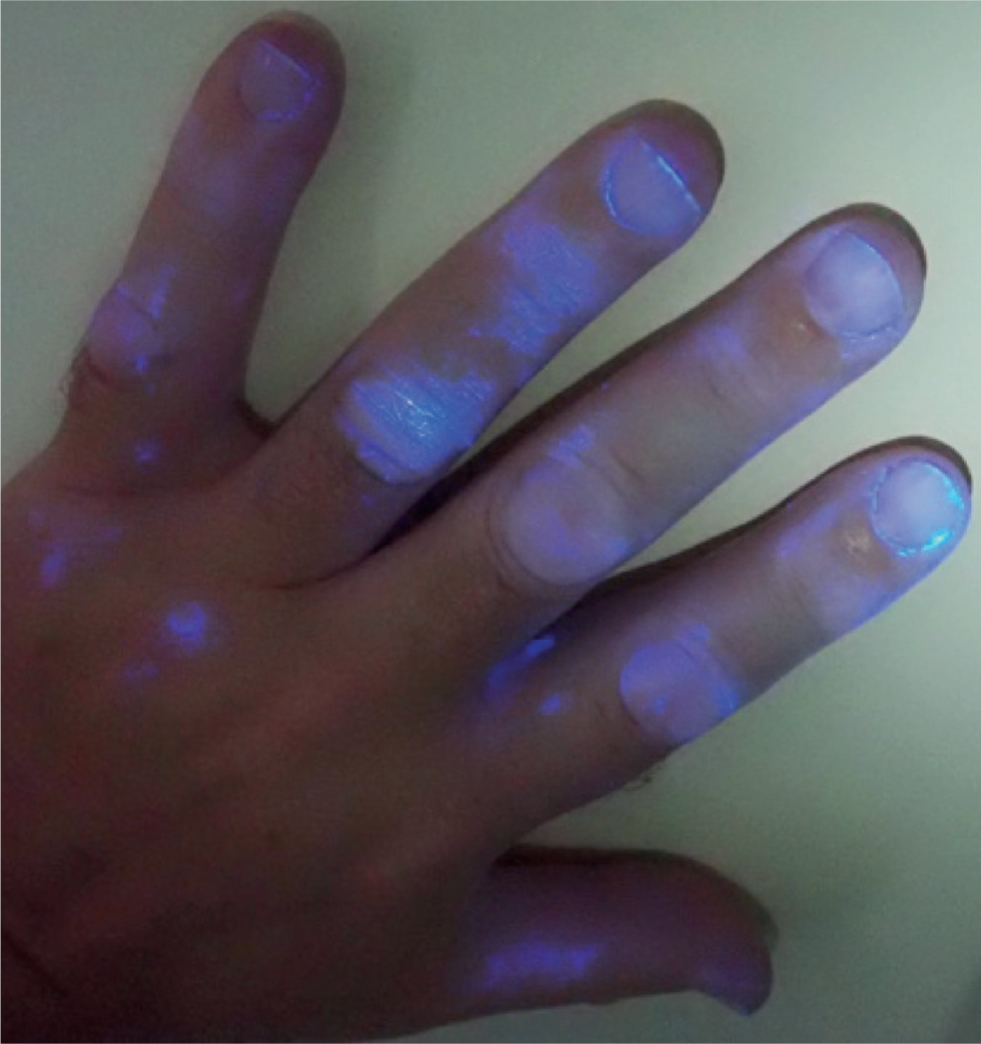

Antibiotic free farming
Before any farm considers doing antbiotic free farming the health team must review the biosecurity arrangements, and resolve any deficits. While the industry continues to make excellent strides towards reducing antibiotic usage, attention to detail with respect to external and internal biosecurity remains a key element in minimising clinical disease outbreaks. It is essential that the appropriate prescription of antimicrobials is not thwarted in the pursuit of an antibiotic free premium. Animal welfare must always be paramount.
Conclusion
Biosecurity practices help to keep farmed animals healthy and reduce reliance on antimicrobials. There is a huge potential cost-benefit to adopting a thorough and inclusive approach. The whole team should be asked to consider ways to reduce the possibility that new diseases will gain entry to their farm and how they might minimise spread within the unit.
KEY POINTS
- Biosecurity is not just about people.
- Biosecurity is the control of specific pathogens not diseases.
- Biosecurity to control pig pathogens revolves around pig to pig contact either directly or via a fomite vectors.
- Biosecurity can be enhanced by colour coding of all equipment used with a batch.
- Biosecurity can be enhanced by the farm supplying veterinary surgeons with essential equipment including a postmortem tools.
- Biosecurity needs a set of written standard operating protocols.


